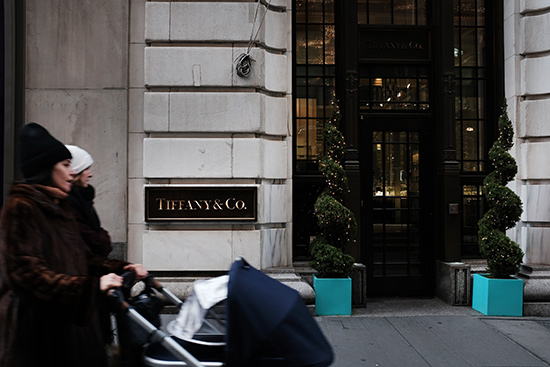有路威酩軒加持,蒂芙尼有望成為真正的奢侈品品牌

|
路威酩軒終于讓蒂芙尼點頭了,于是在11月25日宣布,以162億美元的價格收購這家標志性的紐約珠寶商。 這是奢侈品行業迄今最大的一筆交易,將會推動法國巨頭路威酩軒的珠寶業務,它在這一塊業務上一直落后于瑞士對手歷峰集團。 如果路威酩軒能夠成功提升蒂芙尼不大不小的業務規模的話,潛力還不止于此。 路威酩軒以其龐大的資源,可以讓蒂芙尼——它擁有183年歷史,最為標志性的是蛋殼藍盒子、訂婚珠寶以及因1961年經典電影《蒂芙尼的早餐》而出名的曼哈頓第五大道旗艦店——成為它一直夢寐以求的全球性的奢侈珠寶商。 蒂芙尼有一些見不得人的小秘密:它實際上不能算一個真正的奢侈品牌,比如哈里·溫斯頓和卡地亞那類。它確實也賣高達138000美元一條的項鏈和成噸的鉆石,但其收入的30%來自相對便宜的銀飾品,給人們的觀感是蒂芙尼主要是賣大眾產品的,也就比Zales和Kay高檔一點點。 路威酩軒有著帶領品牌提升的良好記錄,這也告訴了我們它會怎么提升蒂芙尼。2011年時,路威酩軒收購了意大利的珠寶商寶格麗,重視推廣該品牌的歷史傳承和耀目產品,讓寶格麗重煥生機。從彭博新聞提供的業績數據看,寶格麗的營收翻倍。值得一提的是,蒂芙尼的首席執行官亞歷桑德羅·博格里奧羅,職業生涯早期曾經在寶格麗工作過。(收購后博格里奧羅是否會留任的問題,蒂芙尼沒有立即給出答復。) 路威酩軒還可以幫助蒂芙尼把手表業務的潛力發揮出來。2015年,在結束了與斯沃琪的長期伙伴關系后,蒂芙尼重新推出了男款手表業務,至少試圖這么做。公司主管們指望著蒂芙尼在制表上的歷史榮耀能夠幫助取信于大買家們,并讓蒂芙尼重登手表業務舞臺。(1868年,蒂芙尼造出了美洲大陸的第一款跑表。)但從去年的業績看,盡管費盡心力,鐘表類業務僅占公司44億美元銷售額的1%。 路威酩軒旗下擁有泰格豪雅、尚美、宇舶和真力時等多個手表品牌,將很可能幫助蒂芙尼擴大手表業務,并進入蒂芙尼尚未涉及的女款手表領域。 在擁抱電商業務方面,蒂芙尼的步伐也顯緩慢。雖然蒂芙尼也與Farfetch之類的平臺合作,但在去年,算上電話銷售訂單,非實體店的銷售只占蒂芙尼整體銷售額的7%,之前的兩年也是同樣比例。路威酩軒的能量,應該能夠幫助蒂芙尼擴展電商業務。 作為一家國際性奢侈品巨頭,毫無疑問路威酩軒可以幫助蒂芙尼最終成為一個真正的全球性品牌,而不是一家試圖在國外擴展的美國公司。1837年成立于紐約的蒂芙尼,仍舊高度依賴美國國內市場,有41%的銷售來自本土。(這其中又有10%來自那標志性的第五大道旗艦店。)而在美洲大陸的銷售額中,有90%來自美國,今年上半財年,蒂芙尼在美洲的銷售額下跌了4%。 蒂芙尼在美國的擴展主要是在郊區商場里開實體店,有些店的布置稱不上是奢侈品店的布局。 一位華爾街分析師認為,蒂芙尼應該關閉一些美國的實體店,作為一家不再需要作出季度業績報告的公司,這么做是比較容易的。蒂芙尼“在非美國市場的效率更高,可以反觀該如何提高在美國的效率,并把實體店的布局合理化,” Cowen公司的一位分析師奧利弗·陳寫道。 另外,路威酩軒在歐洲的資源和對歐洲市場的深刻了解,將幫助蒂芙尼最終掌握歐洲市場,這個市場是奢侈品行業的基石。上半年蒂芙尼在歐洲的銷售下跌了4%,即便是長期的增長源亞洲,蒂芙尼的業務表現也是喜憂參半。而旗下擁有包括路易威登、克里斯汀·迪奧和紀梵希等多達75個品牌的路威酩軒——業務范圍覆蓋從服裝到酒類到珠寶——懂得如何在中國擴張,以及選擇最佳地產。 或許最重要的是,路威酩軒的資源和運作能力,可以幫助蒂芙尼盈利更多。蒂芙尼的法國競爭對手奢侈品珠寶商卡地亞,其特色是推出新產品以及更能贏得新客戶,號稱運營利潤是蒂芙尼的兩倍。 根據將在2020年中達成的收購交易的條款,如果蒂芙尼的股東在協議上簽字,路威酩軒同意支付每股135美元,或以此價格上溢37%,之后在上月媒體就報道了這筆潛在的交易。(財富中文網) 譯者:宣峰 ? |
LVMH has finally gotten Tiffany & Co. to say yes, announcing a deal on November 25 to buy the iconic New York jeweler for $16.2 billion. The deal, the largest ever in the luxury goods industry, will bolster the French conglomerate’s jewelry business, which has long lagged that of Swiss rival Richemont. But the potential upside goes further than that if LVMH succeeds in improving Tiffany’s middling business performance. LVMH and its massive resources could turn Tiffany—an 183-year-old company iconic for its robin egg blue boxes, engagement jewelry, and the Fifth Avenue flagship in Manhattan made famous in the classic 1961 motion picture “Breakfast at Tiffany’s”—into the kind of global luxury jeweler it has long striven to be. Here is Tiffany’s dirty little secret: It’s not really a luxury brand like, say, a Harry Winston or a Cartier. Sure, it sells $138,000 necklaces and tons of diamonds. But about 30% of its revenue comes from relatively inexpensive silver items, giving Tiffany something of a mass product image in a big part of its business that’s only a couple of notches above a Zales or a Kay Jewelers. LVMH has a good track record of taking a brand upmarket and that will inform what it does to lift Tiffany up. In 2011, it bought Italian jeweler Bulgari and focused on that brand’s heritage and standout products, restoring its aura. As a result, revenue has doubled, according to Bloomberg News. It’s worth noting that Tiffany CEO Alessandro Bogliolo worked at Bulgari earlier in his career. (Tiffany did not immediately respond to a question about whether Bogliolo will stay.) Watches are another area where LVMH can help Tiffany finally reach its potential. In 2015, the company relaunched its men’s watch business, or at least tried to, after a long partnership with Swatch fell apart. Executives were hopeful Tiffany’s previous history in watchmaking would lend it credibility with big spenders and make it a player again. (In 1868, Tiffany made the first stopwatch in America.) But last year, for all of those efforts, timepieces still only generated 1% of the company’s $4.4 billion in sales. LVMH, which owns watch brands TAG Heuer, Chaumet, Hublot, and Zenith, will likely help Tiffany bolster that business and get into women’s watches, where Tiffany is absent. Tiffany was also slow to embrace e-commerce, though it has sought to address that with partnerships such as the one it has with Farfetch. Last year, including orders by telephone, non-store orders only generated 7% of Tiffany sales, the same percentage as the two prior years. LVMH’s firepower should help it finally build up its e-commerce further. As a major international luxury conglomerate, LVMH can arguably help Tiffany finally become a true global player, rather than an American company trying to branch out abroad. Tiffany, founded in New York in 1837, is still highly dependent on the domestic market, getting about 41% of sales there. (About 10 percentage points of that comes from its iconic Fifth Avenue flagship.) But sales in the Americas, 90% of which come from the U.S., fell 4% in the first half of the current fiscal year. Much of Tiffany’s U.S. expansion has centered on opening stores in suburban malls, some of which don’t quite reach the status of a luxury space. One Wall Street analyst said Tiffany could close some U.S. stores, something easier to do as a company no longer required to report quarterly results. Tiffany’s “productivity is better in non-U.S. markets which could indicate opportunity to raise productivity in the U.S. and rationalize square footage,” Cowen analyst Oliver Chen wrote in a note. In addition, LVMH’s resources and deep understanding of Europe might help Tiffany finally master that market, the bedrock of the luxury industry. Sales in that market were down 4% in the first half. Even in Asia, long a source of growth for Tiffany, business has been a mixed bag. LVMH, whose massive portfolio of 75 brands includes the likes of Louis Vuitton, Christian Dior, and Givenchy—and ranges from clothing to alcohol to jewelry—knows how to expand in China and choose the best real estate. And perhaps most crucially, LVMH’s resources and operational prowess might help Tiffany become more profitable. Rival French luxury jeweler Cartier, which has been more deft at launching new products and more successful at winning new shoppers, boasts operating profit margins twice those of Tiffany. According to terms of the deal, expected to close in mid-2020, LVMH agreed to pay $135 per share, or a 37% premium above the price before media reports surfaced about a potential deal last month, if Tiffany shareholders sign off on the deal. |













